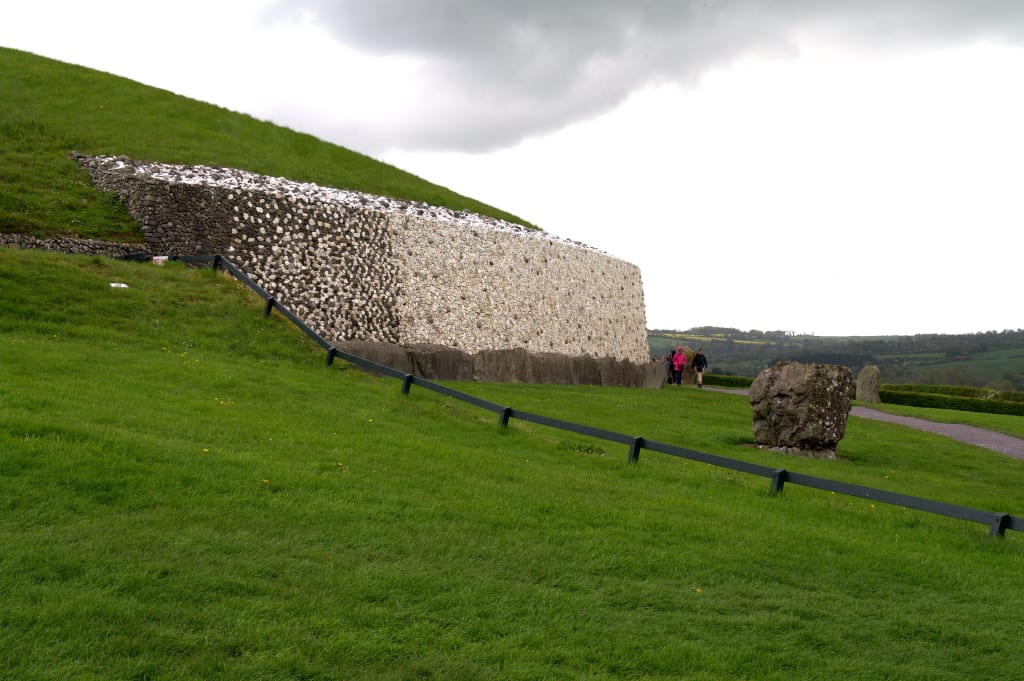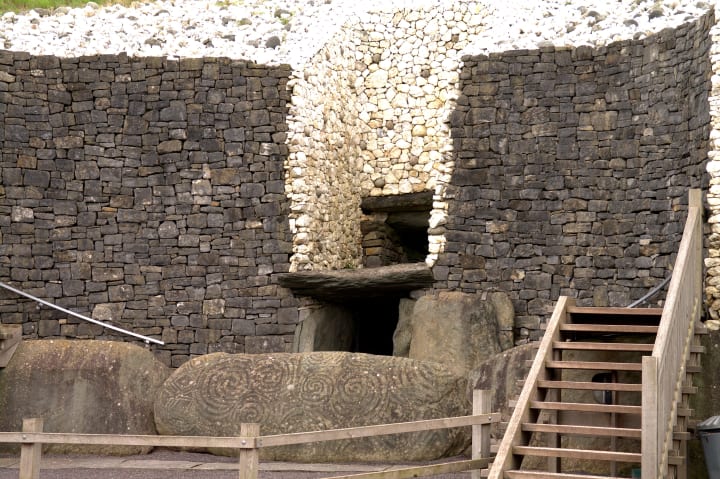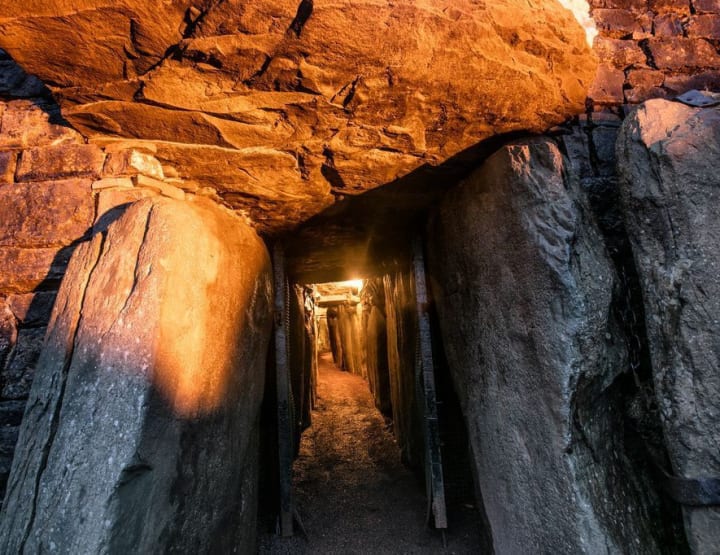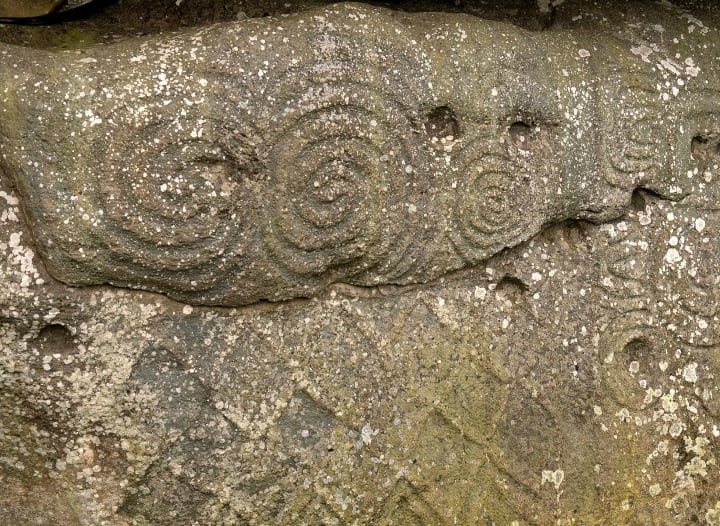Revenge of the Stone People
Those relics from the Stone Age only tantalize and tease us

Okay stone people, you got me. I visited Newgrange, your ancient Irish burial site and I think I hurt myself trying to figure out what your stone age society was all about. Sure, it was interesting but the squeezing and squirming through the stone, cold passageway took a toll on my back. I should have stuck to the brochure but no, I had to see for myself.
Newgrange is a large passage tomb located at a bend in the Boyne River in County Meath in western Ireland. From the distance, it looks like a large grassy mound. Closer inspection reveals an entrance leading to a narrow interior passageway and a series of chambers at the other end. This is where the dead were cremated. Carbon dating says Newgrange was built more than 5,000 years ago, earlier than Stonehenge and the pyramids and two thousand years before the Celts arrived from Europe.
I’m a history buff and those dates got me interested. The site was discovered over 300 years ago by a local farmer who thought it was a quarry and although people knew about it for centuries, the interior passageway and chambers weren’t properly examined by archeologists until 1962. Newgrange was opened to the public in 1975 and it was declared a UNESCO World Heritage site in 1993. I toured Newgrange in pre-Covid days. It is not for the immobile or claustrophobic.

It started easily enough. We were greeted by a friendly and knowledgeable guide and led into the tomb single-file. The passageway was cold and dark, illuminated only by her flashlight bouncing off the walls and ceiling. It was a tight squeeze. I brushed against huge stone slabs and at one point had to bend over to avoid hitting my head. Man, those stone age people must have been short. Seventy feet later we arrived at the end - one large chamber and two smaller ones off to the sides. I noticed a lot of neolithic art, circles and swirls carved into the walls and especially the ceiling. And I noticed something else too. Newgrange is a triumph of engineering. The entire space was constructed of stone slabs of various dimensions carefully positioned so that the entire structure was self-supporting. Back in the day, the builders didn’t use mortar.
And another revelation. Every winter solstice, on or about December 21, the sun strikes the place at such an angle that the rays travel all the way down the passageway and flood the chambers in a bright light. It only happens on the winter solstice. Is this divine intervention, an offering from the ancient sun god Dagda? Many think the tomb has a mystical purpose and gather at Newgrange every December 21, like their brethren at Stonehenge in England, to celebrate the change of season. Not wishing to miss a party, Newgrange holds a lottery every December to determine who can enter the tomb and experience the phenomenon for themselves. It’s even live streamed.

Who built Newgrange ? Researchers think it was farmers because hunter gathers wouldn’t stick around long enough to build something that large or sophisticated. Agriculture ties people to the land. Yet, there’s no archeological record of a permanent settlement anywhere near the mound. Was Newgrange a sacred site constructed by builders living elsewhere? Was it a temple you travelled to?
Unfortunately, Stone Age people didn’t leave many clues about themselves and their society. They did leave a lot of these passage tombs around though. Newgrange is similar to other structures found along the Atlantic coast stretching from Brittany to Scotland. Although they differ in size and complexity, they all share the same architecture and serve the same purpose. The interior space is laid out in the shape of a crucifix, a single passageway leads to a number of burial chambers, and all acknowledge the cycle of the sun and the winter solstice although interestingly, a passage tomb in Wales is oriented towards the summer solstice and not December’s. Although separated by centuries and distance there’s a commonality about them. Intrigued, the School of Archeology, University College Dublin is now engaged in a four-year study of passage tombs in Ireland, Wales and the Orkneys to find out more about that connection.
They’ll be bringing an extensive collection of tools to the table. Molecular-level analysis of teeth and bone fragments can reveal how mobile that person was and how far they likely traveled. It can also find traces of lipids – residue of oil, fats or waxes - on whatever artifacts are placed in the chamber. For instance, at Newgrange, researchers found milk residue on shards of pottery, suggesting the local population was raising dairy cows as well.

I hope that study solves some mysteries. Roman coins were found inside Newgrange and Viking graffiti was found inside Maes Howe, another passage tomb located on mainland Orkney and built 600 years before Newgrange. But that only muddles the picture. The Romans never settled in Ireland and the Vikings arrived in the Orkneys 3,500 years after Maes Howe was built. I guess the Norsemen moved in later to take advantage of something that was already an already built.
For myself, I’d like to know more about Stone Age mobility. Are the passage tombs destination temples or simply repositories for the dead? And who spread the word? No mail, telephone or internet in those days. More to the point, how did information about form, method and materials travel from one location to another, centuries before sea-faring Vikings hit the shores of Scotland, Wales. and Ireland? Enquiring minds want to know.
About the Creator
John Thomson
Former television news and current affairs producer now turned writer. Thanks Spell Check. Visit my web page at https://woodfall.journoportfolio.com
Reader insights
Nice work
Very well written. Keep up the good work!
Top insight
Easy to read and follow
Well-structured & engaging content






Comments (1)
If but not for me claustrophobic I would love to see the inside. Thanks for the surrogate tour. Nicely written.